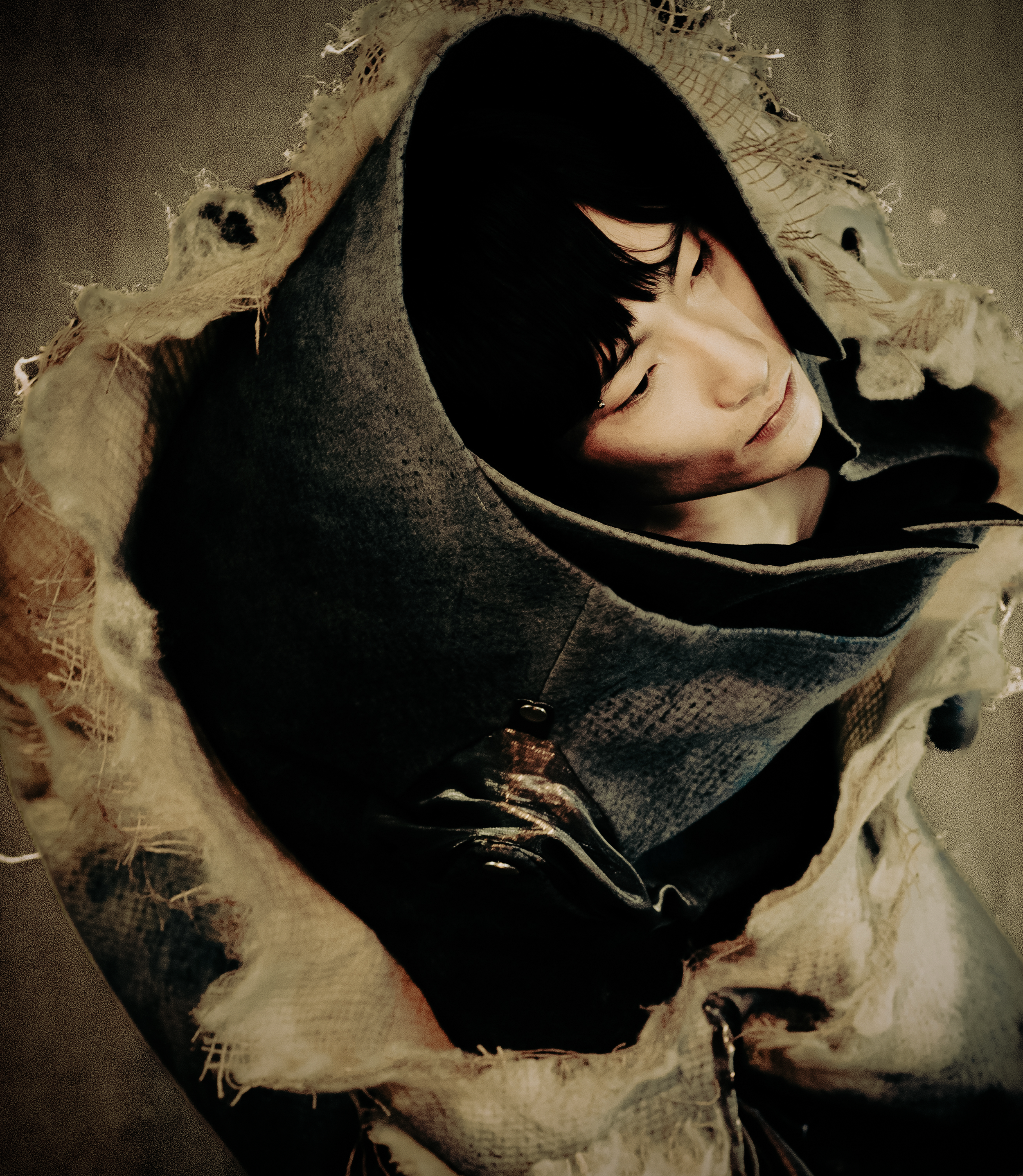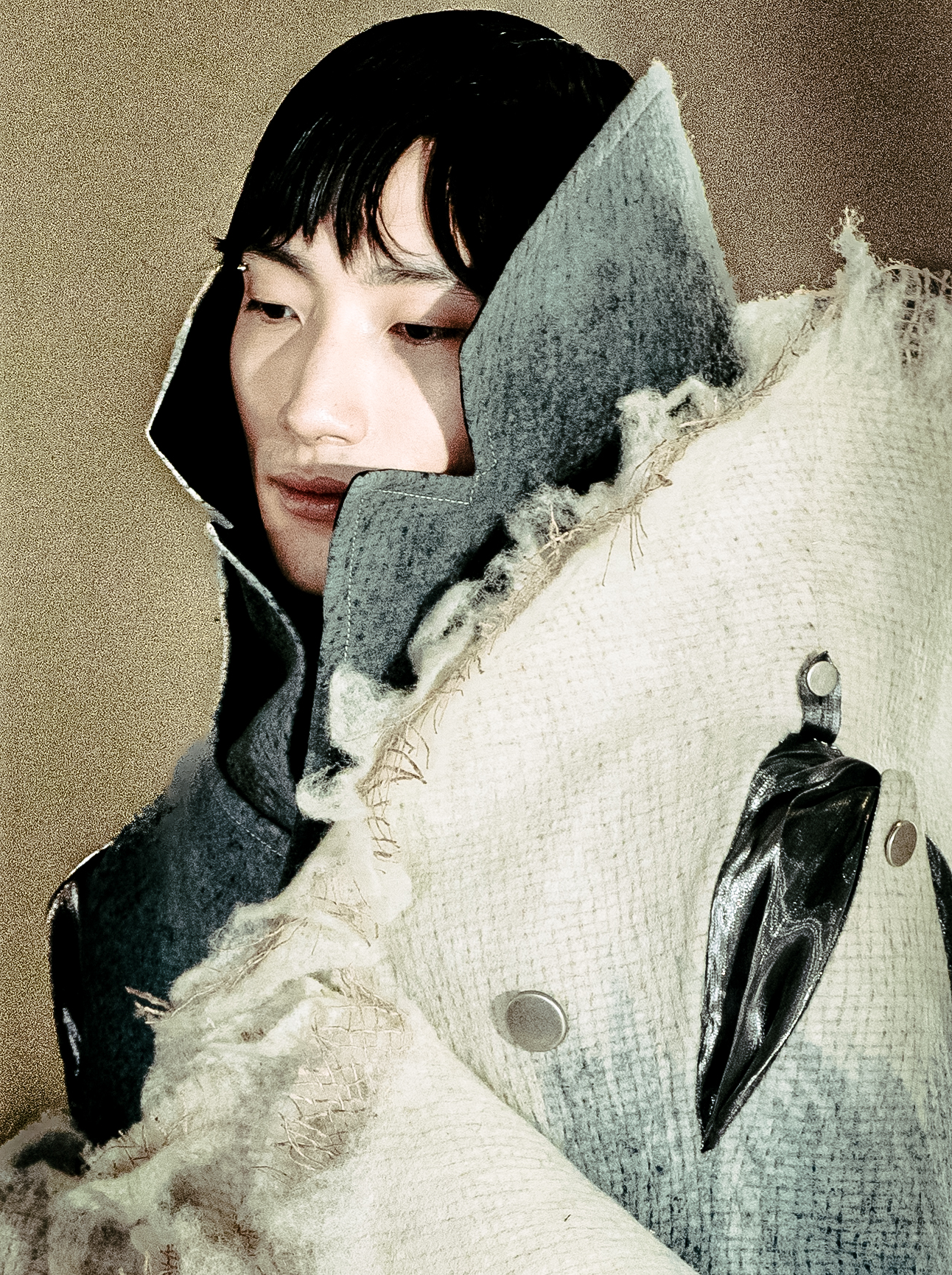Talent Talks: Sybrand Jansen
Image by Shahin Hefter
The by-product of short staple wool is often considered waste. These very short fibres have been felted around a jute grid by Cloudwool, a British manufacturer that repurposes European sheep wool. The jute provides tensile strength, allowing a fragile fibre to become something both delicate and resilient.
Fashion designer Sybrand Jansen draws from ancestral, nature-bound techniques, embracing both refinement and rawness. Inspired by Robert Eggers’ The Lighthouse, the collection evokes two men trapped in isolation, unravelling at the edge of madness, their realities blurring with oceanic delusions. A sailor consumed by the sea, fragments of his wreckage clinging to his body; jute and felted wool mimic boat debris, salt and myth. Regeneration appears here not as restoration but as metamorphosis: erosion and rebuilding of form, where decay, repair and rebirth are all part of a garment’s life.
Could you please introduce yourself?
My name is Sybrand Jansen, 26, from the Netherlands. My work lies in fabric development and patterncutting, but at its core it’s about transformation. I am fascinated by ancestral, nature-bound ways of making and want to be part of their search for context in our modern world.
Having graduated recently, how do you look back on your studies?
The last four years were turbulent, but also transformative. Working under the pressure of the academy taught me to turn foggy fantasies into reality, and to embrace both refinement and rawness in my process. As I’m stepping out of the safe bubble of school, I feel both excitement and a sense of in-betweenness. Yet I carry the confidence that creation is never linear, and that uncertainty can be the most fertile ground.
Image by Shahin Hefter
Could you please tell us something about your graduation collection/project?
My graduation collection is inspired by Robert Eggers’ film The Lighthouse. Two men, trapped on a small stormy island in the middle of nowhere, struggle to keep the light alive as isolation blurs reality and delusion. Knotted, weathered, eroded by the sea, yet softened by their mermaidlike fantasies of femininity
Which materials, techniques, programmes and/or applications are you mostly interestedin? Please specify your use and views on wool
For this collection I tried to capture the turbulent power of the sea, and the way it can turn a ship into a shipwreck in the blink of an eye. This look symbolizes the wild sea, devouring a sailor, while the jute emerging from the foamy felted wool recalls fragments of his broken boat.
For this piece I worked with Cloudwool, a British manufacturer that repurposes European sheep wool thats often considered waste by mass production, and transforms it into innovative felted fabrics.
This fabric in particular uses very short staple wool, felted around a jute grid. The jute provides tensile strength, allowing a fragile fiber to become something both delicate and resilient.
Image by Shahin Hefter
The exhibition you are a part of looks into the meaning of regeneration. What does regeneration mean to you and your work?
Regeneration, to me, is the constant shifting of forms. An openness to the different shapes things around us can take over time, and where endings are also seen as new beginnings. Just as the sea erodes and reshapes the shore, fashion too must recognize that nothing is static: materials, garments, and even ideas can be reborn. In my work, regeneration means embracing these cycles, letting decay, repair, and renewal coexist within the life of a garment.
How do you perceive the meaning and importance of community within the fashionfield?
I believe the essence of fashion is community. A garment does not exist in isolation, it carries with it the imagination of the designer, the skills of the maker, and the presence of the wearer. These communities are often separated, invisible to each other, and I think something vital is lost in that disconnection. Fashion has the power to bridge these divides: In the same way that the design team is able to witness the people they are dressing, the audience should see the hands and labor of the communities that shaped their clothing. For me, the future of fashion depends on this visibility, where community is not hidden but celebrated as the foundation of every piece.
How do you view the future of fashion? And your own role therein?
It’s a fascinating moment to be in fashion. So much already exists, yet we feel the natural desire for ‘the new.’ I think the designer of the future will think bigger — they don’t see themselves as merely a designer of garments, but as a conscious developer, shaping the full life cycle of a garment: from production (birth), to wear (life), to decay (death), to regeneration, with the same love and creativity as when designing just a coat.
Within this same philosophy, I want to build my own systems of creation. I am currently working with Indian hand-weaving mill 7 Weaves, where we are co-designing the full production and life cycle: from the first silk cocoon being gathered, to the garments being stitched in the same village, and how the design and patterns of these pieces can highlight and respect the cycle they are in.


